U.S. Department of Transportation
Federal Highway Administration
1200 New Jersey Avenue, SE
Washington, DC 20590
202-366-4000
| < Previous | Table of Content |
When bicycle and pedestrian programs began in the late 1960's, the emphasis was strictly on providing facilities. As communities gained experience and began to identify other needs, the concept of the comprehensive "4-E" program emerged, combining the elients of engineering, education, enforcement, and encouragement.
The past 30 years have seen a great deal of growth and much creativity in the field. Communities with long-standing bicycle and pedestrian programs have developed a wide variety of programs to educate local citizens, encourage more bicycling and walking, and enforce the rules of the road. This is in contrast to a far greater number of communities that have begun building new facilities-through the funding infusions of the Intermodal Surface Transportation Act of 1991 (ISTEA) and the Transportation Equity Act for the 21st Century (TEA-21), but have not begun to establish support programs in the areas of education, enforcement, and encouragement.
This lesson explores the fundamental features of education, enforcement, and encouragement programs for bicycling and walking, providing examples of successful programs from around the country.
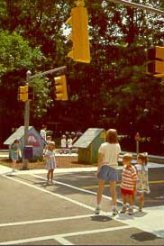 A mock-up of a miniature downtown area enables these children in Greensboro, NC, to learn pedestrian safety. |
Historically, providing for bicyclists meant providing bicycle facilities. This was the focus during the early phase of program development in the United States, but by the late 1970s, it was replaced in some progressive communities such as Boulder, CO, and Madison, WI, with a more comprehensive 4-E approach, which combined engineering and planning with enforcement, education, and encouragement. By then, it had become clear that simply providing a bicycle- and pedestrian-friendly road or trail environment, as important as it is, cannot solve all bicycle and pedestrian problis. Some safety problis, for example, may be more easily solved through programs than through facilities. In order to understand the importance of the other elients of a comprehensive program, consider the following two examples:
Example 1: A person decides to ride her bicycle to work. Between home and the office, there is a road with bicycle-friendly design features (e.g., wide outside lanes, bicycle lanes, etc.). While riding, she barely misses a 10-year-old wrong-way rider coming at her, is almost cut off by a motorist turning left in front of her, and finally finds no place to securely park her bicycle at the office. She locks her bike to the leg of a newspaper rack and goes into the office. When she leaves work, the sun has gone down; she has no bike lights. She calls a taxi to take her and her bicycle home.
Analysis: While she was able to take advantage of one elient of a comprehensive program (the onroad facilities), the lack of other elients caused her serious inconvenience and danger. Youngsters need to learn which side of the road to use and the traffic laws should be enforced; motorists should learn to watch for bicyclists and to yield to them just as they would to other motorists. These common bicyclist and motorist errors lead to many crashes and may be addressed through education, enforcement, and awareness programs. Secure and convenient bicycle parking should be provided at all popular destinations as a routine matter. In some communities, this is dealt with in the parking ordinance.
Example 2: A person gets in his car on a sunny summer afternoon to drive to a nearby store. The store is less than a mile away and he is buying a quart of milk. There are sidewalks, but he doesn't even think of walking. He drives there, buys his milk, and drives home. In so doing, he contributes to air quality and congestion problis. And he wastes gasoline.
Analysis: While the existence of sidewalks or places to walk is important, it does not necessarily convince people to walk if they habitually take a car for every trip. The average American household generates 10 auto trips per day and many of them are shortdistance errands. Breaking the driving habit requires effort and understanding. A good awareness campaign, including media spots and other elients, can help develop that understanding and encourage people to make the effort to walk for short trips. Walking takes little extra time compared to driving for very short distances. When one considers the costs (environmental, economic, personal health) of driving, and the exercise and health benefits of walking, walking is often preferable.
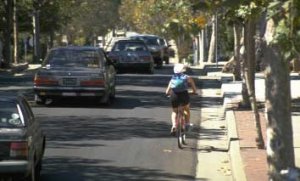
The lack of education and awareness among bicyclists and motorists can
be
addressed through new programs aimed at both adults and children.
These two hypothetical examples point out the importance of going beyond the old focus on facilities alone to include other aspects as well. They suggest the potential roles that agencies such as the police department, the school district, and private parties such as the local television station and newspaper can play in improving the bicycling and walking situation in a community. It is important to keep in mind that some elients may not contribute directly to increased numbers of nonmotorized travelers. However, these elients are important for other reasons, primarily safety.

How, exactly, can a successful mix of engineering, enforcement, education, and encouragement be determined? The answer is that participants from a wide range of agencies and groups must get involved in the process. The Geelong, Australia, model is a good one to illustrate this point. The Geelong Bike Plan Team included members from the enforcement community, roads department, safety agencies, school system, and bicycling community. In assembling their comprehensive program, the project managers enlisted the help of those who would, ultimately, be responsible for implienting it.
This is the process suggested here. A "bikepedestrian plan task force" should be assembled to mold and steer the program. The following structure is suggested for the task force. While the same department may be represented on several subcommittees, this would not necessarily require different individuals. Individual members should deal with those aspects within their areas of expertise.
Subcommittees:
Physical environment
Education and awareness
Encouragement
Data collection
Public works (traffic engineering, streets)
Planning (transportation, land use)
Parks and recreation (parks planning)
Cyclists and pedestrians
College campus planning
Parks and recreation (programming)
School district (elientary and junior high)
High school and college
Health Cyclists and pedestrians
Police (traffic)
Cyclists and pedestrians
Because so little is known about the bicycling and walking situations in most communities, it is difficult to predict in advance what level of expenditure and program activity will be needed to implient a comprehensive program. Until the needs have been identified and the problis assessed, the necessary scope of the program will probably remain unknown. However, the basic approach suggested here is to make bicycle and pedestrian considerations part of the normal process of governing. In many cases, this may require little extra expense.

The most successful bicycle and pedestrian education programs for children
are impliented through local school systems.
For example, if a police officer stops a bicyclist for running a red light, this should not be seen as a new or extra duty. It is simply part of traffic enforcement and it will pay the community back in terms of decreased crash rates. Similarly, adding pedestrianor bicycle-related questions to a transportation needs survey will not necessarily require large amounts of money. It allows transportation planners to do a better job of planning for the community's travel needs and can pay off in reduced motorized travel demand. Finally, changing from a dangerous drainage grate standard to a bicycle-safe design costs no more, but can reduce an agency's potential liability.
There will be some projects (e.g., a new bicycle bridge) that require a significant expenditure of funds. However, if the need for a project is clearly documented through surveys and studies, it can take its place in the Transportation Improvement Program. In such an arena, its strengths and weaknesses can be weighed against those of other potential projects.
There are four primary steps in the process of mixing the elients of engineering, education, enforcement, and encouragement to create a comprehensive bicycle-pedestrian program.
First, it is important to develop an understanding of the local bicycling and walking situations. This means looking closely at non-motorized travel in the community, determining its limitations and potential, as well as current levels of use and safety problis. This understanding forms the basis for the work that follows.
The second step is to set realistic goals and objectives. These should be based on data from the information- gathering step and they should be measurable and achievable.
Third, participants should address those goals and objectives through the development of an action plan. The plan should be a blueprint for the community's work in all the elients of the comprehensive program. It should include phasing and funding considerations.
Fourth, as work on the action plan progresses, it should be evaluated based on its effects on the goals and objectives. Without an evaluation process, it is impossible to determine the effects of one's work. With evaluation, one can judge and document success, correct errors, and fine-tune the program.
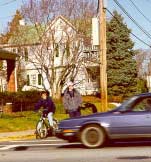
New and returning university students should be included in training programs.
It is during the first few weeks of classes that most crashes occur.
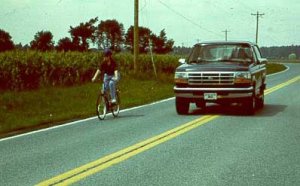
Education programs should target adult bicyclists and motorists.
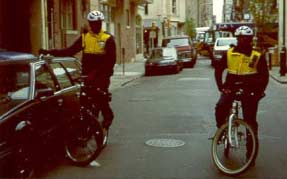
Philadelphia, PA police officers use bicycles to patrol city streets.

Promotional flyers can give safety tips, rules, and specific laws, and contacts and resources in the area.
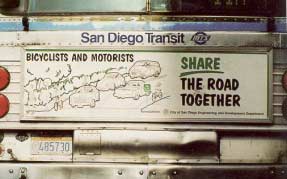
Local agencies can work together to promote bicycling and walking, transportation,
and safety.
A comprehensive bicycle-pedestrian program directed toward the goal of increasing safe travel by non-motorized modes must combine the efforts of many people. No one office can do it all. Officials in public works, planning, enforcement, education, and recreation agencies all have a role and must work together to achieve the desired end.
In order to measure future success, it is important to first determine current conditions. Since nonmotorized travel is so seldom measured, we know little about it. With data on use, user attitudes and behavior, safety, and security problis, it is possible to begin assembling an achievable set of goals and objectives. These goals and objectives should be used to guide the development and implientation of an action plan. The plan should include physical elients such as roadway improvements and trail systems, as well as non-physical elients such as enforcement and educational programs.
Evaluating the elients of the action plan is a critical step in determining future direction and past success. Success should be measured both in terms of services delivered and effects achieved. Evaluation must be seen as a key ingredient to implientation, rather than as an extra duty to be performed if there is time or money.
Combining these steps into a comprehensive program will allow a community to achieve and measure success.
Text and graphics for this lesson were derived from:
Federal Highway Administration, National Bicycling and Walking Study, Case Study 11: Balancing Engineering, Education, Law Enforcement, and Encouragement, 1994
| < Previous | Table of Content |
